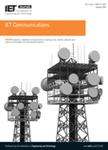版权所有:内蒙古大学图书馆 技术提供:维普资讯• 智图
内蒙古自治区呼和浩特市赛罕区大学西街235号 邮编: 010021

作者机构:Xi An Jiao Tong Univ Sch Elect & Informat Engn Xian 710049 Shaanxi Peoples R China China Acad Engn Phys Inst Comp Applicat Mianyang 621999 Sichuan Peoples R China ZTE Corp R& Ctr Xian Xian 710049 Shaanxi Peoples R China
出 版 物:《IET COMMUNICATIONS》 (IET通信)
年 卷 期:2018年第12卷第20期
页 面:2552-2560页
核心收录:
基 金:National Natural Science Foundation of China Key Research and Development Plan of Shaanxi Province [2018ZDCXL-GY-04-07] Fundamental Research Funds for the Central Universities
主 题:radio networks convex programming relay networks (telecommunication) iterative methods telecommunication security concave programming cooperative communication array signal processing approximation theory multipair legal users multiple untrusted relays nonconvex problem multiple user pairs secure communications multipair two-way relaying physical-layer security legitimate source legitimate user pairs secure transmission wireless relay networks convex subproblems secrecy sum-rate maximisation artificial noise injection cooperative beamforming multiple noncolluding eavesdroppers semidefinite relaxation Taylor series approximation iterative algorithm
摘 要:Physical-layer security is usually ensured by the injection of artificial noise (AN) at the legitimate source or destination when relays are cooperative but untrusted. In this work, in order to avoid the power-consuming AN at the legitimate user pairs, the authors investigate multi-pair two-way relaying as a solution for secure transmission in wireless relay networks with untrusted relays. They formulate a generalised problem for the joint design of cooperative beamforming (CB) and AN at relays to maximise the secrecy sum-rate in wireless networks with multi-pair legal users, multiple untrusted relays as well as multiple non-colluding eavesdroppers. Further, they reformulate, approximate and relax the original non-convex problem into a sequence of convex sub-problems based on semi-definite relaxation (SDR) and Taylor series approximation. Particularly, for the reformulated problem they prove that the SDR is in fact tight, and hence propose an iterative algorithm for CB and AN design at the relays. In the simulations, they demonstrate the fast convergence and high achievable secrecy sum-rate of the proposed algorithm. Also, they simulate and discuss the impact of the number of user pairs on the secrecy sum-rate, and reveal the change of performance gain with the number of multiple user pairs.